Dell XPS 12 Review: A Jack of All Trades Flipscreen Ultrabook
by Jarred Walton on February 22, 2013 2:13 AM EST- Posted in
- Laptops
- Dell
- XPS
- Intel Insider
- Ultraportable
- hybrids
- Ultrabook
Battery Life Testing
As discussed in the Acer S7 review, we’re doing away with our former battery life suite and going with a bit more up-to-date tests. This is only the second laptop we’ve run through the new suite, so our database is a bit bare, so I’m just going to throw the results into a table. The Light test is our former Internet test, only with the LCD at 200 nits (50% for the XPS 12, or five steps down from maximum). Our Medium test uses the same Internet testing procedure but loads the pages every 12 seconds instead of every 60 seconds, and we add in playback of a bunch of 128Kbps MP3 files in Windows Media Player (with headphones connected and volume set to a “reasonable” level—around 40% in this case). Finally, for our heavy workload we keep the Internet portion of the Medium test but add in looped playback of a 1080p H.264 encoded video and have a constant 1Mbps download running from a local FTP server.
| 2013 Battery Tests | ||
| Battery Test | Acer Aspire S7 | Dell XPS 12 |
| 2013 Light (Minutes) | 240 | 321 |
| 2013 Medium (Minutes) | 173 | 257 |
| 2013 Heavy (Minutes) | 137 | 183 |
| Light Normalized (Min/Wh) | 6.86 | 6.83 |
| Medium Normalized (Min/Wh) | 4.94 | 5.47 |
| Heavy Normalized (Min/Wh) | 3.91 | 3.89 |
Dell’s XPS 12 wins on pure battery life compared to the Acer S7, but it’s largely thanks to the increased battery capacity. That adds weight as well as thickness, so it’s not necessarily a trade everyone will be willing to make. Interestingly, the Medium test is the exception, where even after normalizing for battery capacity the XPS 12 holds an 11% advantage over the S7. It’s not clear if this is thanks to some power optimizations or something else. Best case, however, we’re still looking at just over five hours of useful battery life between charges, with heavier usage bringing the system to the 3-4 hour range.
When we look at battery life with tablets is where these results are really put into perspective. The Surface Pro manages over five hours of H.264 decoding, but even that pales in comparison to the 10+ hours you can get out of most ARM-based tablets, and the iPad 2,4 makes it to the 15+ hour mark. Screen size and other components clearly play a role (an SSD drawing 0.5W would be a huge penalty compared to drawing 0.1W eMMC), but the entire Microsoft Surface RT device draws around 3W during movie playback at 200 nits compared to nearly 9W for the XPS 12 in our Light scenario and Surface Pro uses around 8W. Intel and their partners need to cut typical power draw in half if they want Haswell devices to be competitive with other SoCs.
Incidentally, at 100 nits and running our older 720p H.264 battery life test, the XPS 12 lasts right about four hours. Turn up the LCD to 200 nits and you can probably knock off another 20 minutes, so just over 3.5 hours of movie playback should be doable.
WiFi Performance
Considering there’s no Ethernet port on the XPS 12, WiFi performance becomes even more important for those that are doing any larger file transfers to/from the device. As someone who uses Gigabit Ethernet (and has been using it for roughly a decade), WiFi performance can be painfully slow. Copying the full suite of tests to a laptop over WiFi (around 18GB of data) can take the better part of an hour, and that’s when you have a good signal and no other interference. Switch to a 2.4GHz connection and things get even worse. Obviously USB 3.0 transfer rates are substantially faster, and for convenience sake I’d like to see some USB 3.0 to GbE adapters (Dell does sell a USB 2.0 to GbE adapter for $30, though I’m not sure what sort of real-world throughput it provides). I’d also like to see Dell and others move to 3x3:3 antenna configurations, something MacBook Pro has had for several years now.

Above is a quick check of WiFi performance compared with some tablets and other laptops. The XPS 12 is about average for a 2x2:2 solution, with slightly better throughput on 5GHz than on 2.4GHz. I’ve seen some WiFi adapters push closer to 150-200Mbps on a 5GHz 2x2:2 solution (e.g. the Amped Wireless adapter), so I’m not sure why most other WiFi adapters are so slow by comparison. Partly it’s probably Intel’s drivers, which may favor reliability or neighbor-friendliness over pure speed, but then on the XPS 12 the reliability aspect wasn’t all that great either.
Display Testing
I have to throw this out before I get into the display calibration results: I’m no longer confident that our testing procedure works properly for Windows 8 laptops. Everything looks okay, but either these new 1080p IPS displays are trading color quality for viewing angles or else the calibration routines aren’t working quite right. I mention this because the XPS 12 has great viewing angles and decent contrast but color accuracy and quality are decidedly average. And that’s after calibration—out of the box, Delta E is probably in the double digits. Here are the charts.
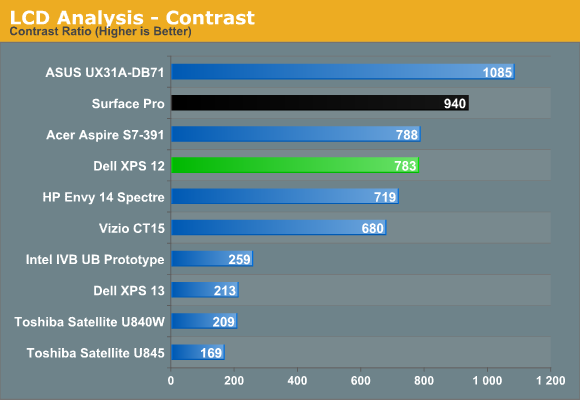
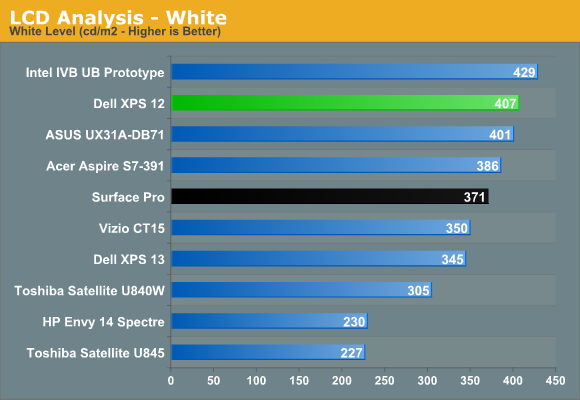
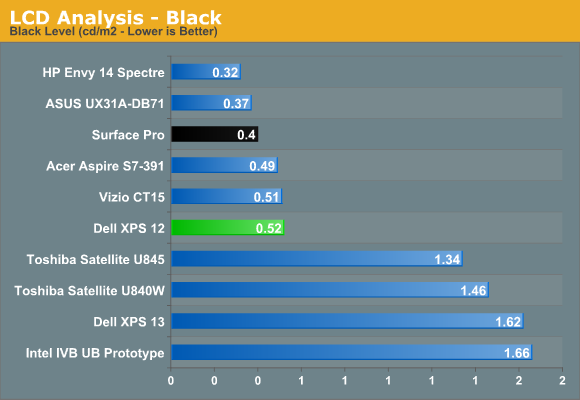
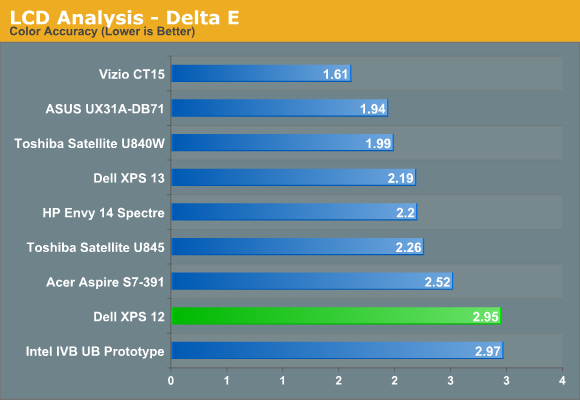
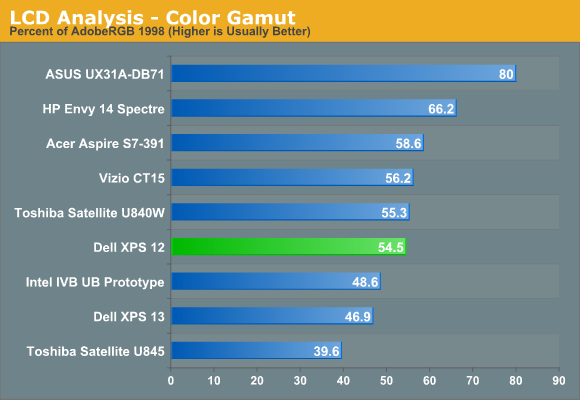
This once again highlights the need for OEMs to take displays seriously; Apple is spending the extra dollar or two (or maybe even five according to some rumors) to calibrate their laptop, tablet, and smartphone displays so that colors are reasonably accurate and color gamut matches the sRGB color space. Virtually everyone else is way off in terms of what colors are supposed to look like. While I can see not spending the extra money on a crappy TN panel in a $400 budget laptop, when we’re looking at $1200+ Ultrabooks the costs argument just doesn’t hold water. Ideally, every Ultrabook should be factory calibrated to deliver an average Delta E of less than three out of the box. Dell gets there post-calibration but only barely, and maximum brightness with the color profile loaded drops to around 300 nits.


_thumb.jpg)
_thumb.jpg)
_thumb.jpg)
_thumb.jpg)
_thumb.jpg)
_thumb.jpg)








59 Comments
View All Comments
nagi603 - Friday, February 22, 2013 - link
My thoughts exactly. I'm looking to replace a rapidly aging tablet PC, and just can't find a good, modern convertible / tablet to replace it with... A shame companies eschew either the 8 gigs of ram, the pen input, the big enough battery or the not-insane price.damianrobertjones - Friday, February 22, 2013 - link
Lenovo Helix. HP 2760p (Ish)uditrana - Wednesday, June 5, 2013 - link
ThinkPad Helix?Fits everything but the insane price.
BrokenCrayons - Friday, February 22, 2013 - link
Though really, for $1200+ dollars, I could buy a lot of ink pens and Marble Composition notebooks which don't seem to suffer from the same battery life problems that a tablet has and are probably somewhat lighter. Dropping one, even from the top of a building, or running over one with a car won't cause a significant enough amount of damage to make the notebook cease to operate either. Of course, you don't get an Internet connection to anything. Still, I'll take $1.75 each from Wally World plus a few cents for a good PaperMate pen for the durability, endurance, and weight savings.-BC
Rick83 - Saturday, February 23, 2013 - link
Weight saving?Have you ever tried to get 1200 dollars worth of pens and paper into your carry-on luggage?
On another note: I don't think the limitation matrix in the post three up is quite correct: Price should be replaced by "with a decent screen".
Currently not even 2500 dollars can buy something that's better in every way, compared to a Thinkpad X60 tablet from 5 years ago (which then cost around 2000 dollars, but was worth the money for those that were looking for pen support.)
twin - Friday, February 22, 2013 - link
I think you mixed up the weight on the table. It shows 2.87 instead of 3.35lbs.Any plans to look at the Lenovo Helix in the future? thanks
JarredWalton - Friday, February 22, 2013 - link
Oops... copy/paste of the Acer table and I missed updating the dimensions and weight. It's fixed now, thanks.As for the Helix, Lenovo has not seeded us with a laptop for review for several years, so unless that changes the only way to review it will be if one of us purchases one. I know personally it's more than I can spend, considering I have other laptops to use that don't cost me anything. I did play with it at CES, though, and it was decent; not sure about the mechanism for attaching to the keyboard base, as it just felt a bit clunky, but dockable tablets and devices always seem to have some issues there.
StormyParis - Friday, February 22, 2013 - link
Darn the first picture is ungly, to the point of making the damn thing broken, I initially thought the screen was on the tablet, separated from the rest of the device.JarredWalton - Friday, February 22, 2013 - link
The glossy display shows reflections quite well, so unless you really try to stage the photos you get a lot of stuff like that. Thought it was a nice shot for those that worry about glossy LCDs. :-)nerd1 - Friday, February 22, 2013 - link
I wonder how long it takes to see the review of Ativ Smart PC (atom) and hopefully Ativ smart pc pro (i5 version)It literally took months...